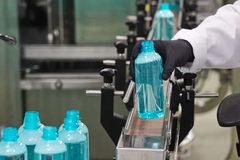Packaging vs. climate change: Industry’s fiber, AI and end-of-life management plans for 2024

17 Jan 2024 --- Traditionally viewed for functionality and aesthetics, packaging’s environmental impact is now at the forefront of the industry. Companies are redefining practices to align with sustainability goals, emphasizing eco-friendly materials, innovative designs and improved recycling.
With environmental groups and civil societies pushing for stronger action from companies and governments alike, incoming regulatory changes worldwide to reduce the impact of packaging waste on the environment and consumer behavior shifts, collective efforts to reduce footprint are underway.
Beyond material choices, the packaging industry is embracing smart technologies. AI and tracking systems enhance supply chain efficiency, reducing waste and emissions linked to transportation, shares DS Smith.
“As an industry, it is exciting that we have so much potential to create long-lasting and impactful change. DS Smith is busy exploring possibilities around material change and sustainable design and, as market leaders, have made significant investments into R&D around alternative sustainable fibers, for example,” Sascha Nicholson, senior sustainability manager at DS Smith, tells Packaging Insights.
As companies adopt sustainable practices and collaborate on innovative solutions, the industry is well positioned to influence consumer behavior and contribute to global climate change mitigation efforts.
Collaboration, integration and lightweight
Susan Brunner, head of product sustainability and positioning at Mondi, emphasizes the company’s collaborative approach. “We work closely with our customers to develop innovative solutions aligned with their sustainability goals,” she explains.  Metsä Board is developing resource-efficient lightweight paperboards fit for diverse global collection and recycling systems (Image credit: Metsä Board).
Metsä Board is developing resource-efficient lightweight paperboards fit for diverse global collection and recycling systems (Image credit: Metsä Board).
“We are committed to making all our packaging and paper solutions reusable, recyclable or compostable by 2025. We work with our customers to develop solutions with sustainable end-of-life and actively engage in cross-industry collaboration and the development of design for circularity guidelines for both flexible plastic and paper-based packaging solutions.”
Meanwhile, Metsä Board details that it is developing resource-efficient lightweight paperboards fit for diverse global collection and recycling systems.
“Metsä Board launched an easily recyclable and compostable barrier paperboard with dispersion barrier coating some years ago, and the barrier development continues in the company. This kind of paperboards can replace plastic in some end-uses,” notes Anne Uusitalo, product safety and sustainability director at Metsä Board.
DS Smith’s Nicholson elucidates that the company’s focus is on integration into the value chain for sustainability. “We are always looking for fresh solutions to old challenges and we work as closely as possible with our customers to innovate and harness unexplored and original approaches and ways of thinking.”
“For example, plastic shrink wrap has long been considered unsustainable and harmful to the environment. Therefore, we have developed a plastic eliminating and 100% recyclable solution and alternative to shrink-wrap for multi-pack bottles called DS Smith Lift Up,” she states.
DS Smith advocates for introducing alternative solutions to customers. “Data is also key to us in terms of looking outside of the existing marketplace at what is possible from the perspective of transforming traditional plastic-based packaging design. We analyze our customer’s value chains and assess their unique challenges, then collaborate with them to find the most innovative solutions that are bespoke for their respective needs,” shares the sustainability manager.
Protecting the forests
Amid the packaging industry’s shift from plastic to fiber-based materials to environmental gains, the European Commission (EC) recently passed a new law obliging all companies using wood-based materials to prove their supplies have not come from deforested land or areas where human rights violations have occurred.  Mondi Hug&Hold is a new paper packaging solution to wrap and transport PET beverage bottles, replacing plastic shrink wrap (Image credit: Mondi).
Mondi Hug&Hold is a new paper packaging solution to wrap and transport PET beverage bottles, replacing plastic shrink wrap (Image credit: Mondi).
Addressing the environmental impact of paper-based material sourcing, Uusitalo affirms that forestry practices at Metsä Board do not contribute to deforestation. “Forestry does not cause deforestation in any of the areas where Metsä Board sources wood, and all sourced wood comes from areas covered with the existing well-known forest certification standards. Safeguarding biodiversity is part of forest management in our wood sourcing areas,” she explains.
Mondi’s Brunner adds: “We believe that an active and sustainable management of forests is key to address the climate crisis and secure long-term benefits for society in the use of renewable materials.”
“In sustainable working forests harvesting does not exceed annual growth enabling forests to regenerate and thrive. Harvesting trees is balanced with efforts to protect biodiversity, water and ecosystem services.”
Mondi’s Due Diligence Management System guides responsible procurement, with 75% of wood supply certified to FSC or PEFC standards.
Additionally, DS Smith’s approach to natural resources and ecosystems undercurrents the company’s circular business model according to Nicholson. “The elimination of plastic pollution is a huge part of our focus as we work with our customers to reduce carbon emissions and design out waste and pollution and keep materials in circulation.”
“Corrugated cardboard is well-established as a sustainable material that can be repeatedly recycled and circulated via an internationally established recovery and recycling process, and the principle of keeping materials in use for longer is a fundamental part of our commitment to Circular Design Principles,” notes Nicholson.
Natural waste management
The companies highlight that effective material management at the end-of-life is equally important to product development.
.jpg) DS Smith shares corrugated cardboard can be repeatedly recycled and is a fundamental part of its Circular Design Principles.Uusitalo points out “naturally recycling is the most recommended option,” for circular economy but in case of gaps Metsä Board’s standard paperboards are industrially compostable.
DS Smith shares corrugated cardboard can be repeatedly recycled and is a fundamental part of its Circular Design Principles.Uusitalo points out “naturally recycling is the most recommended option,” for circular economy but in case of gaps Metsä Board’s standard paperboards are industrially compostable.
Brunner from Mondi discusses the company’s commitment to making all packaging reusable, recyclable or compostable by 2025, stating: “We work with our customers to develop solutions with a sustainable end-of-life and actively engage in cross-industry collaboration and the development of design for circularity guidelines for flexible plastic and paper-based packaging solutions.”
Brunner notes that Mondi has approved near- and long-term net-zero targets, achieving a 17% reduction in absolute Scope 1 and 2 GHG emissions in 2022.
“We report on the performance against our climate action targets transparently in our annual sustainability report and our leading performance has been recognized by external rating agencies for several years, such as CDP,” Brunner tells Packaging Insights.
“Since 2015 we have invested around €650 million (~US$70 million) in energy and process efficiency projects. We consider energy efficiency projects on an ongoing basis and assess their potential to save GHG emissions.”
Nicholson highlights DS Smith’s circular design approach and the consideration of the entire life cycle. “Our Circular Design Metrics approach enables us to design products with a focus on sustainable end-of-life outcomes,” she explains. DS Smith’s circular approach ensures that wastepaper and corrugated materials are recycled into new paper, contributing to a circular economy.
By Radhika Sikaria











